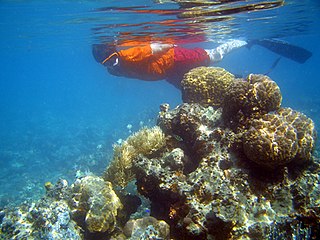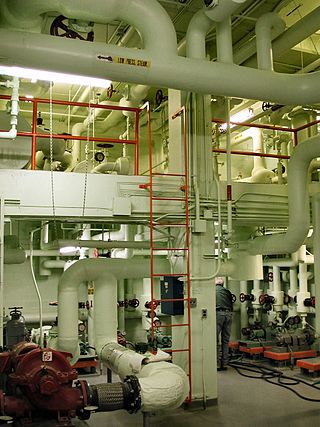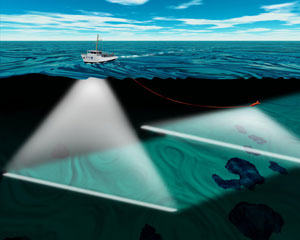
Underwater archaeology is archaeology practiced underwater. As with all other branches of archaeology, it evolved from its roots in pre-history and in the classical era to include sites from the historical and industrial eras.

Snorkeling is the practice of swimming face down on or through a body of water while breathing the ambient air through a shaped tube called a snorkel, usually with swimming goggles or a diving mask, and swimfins. In cooler waters, a wetsuit may also be worn. The snorkel may be an independent item or integrated with the mask. The use of this equipment allows the snorkeler to observe the underwater environment for extended periods with relatively little effort, and to breathe while face-down at the surface.

Radio control is the use of control signals transmitted by radio to remotely operate a device. Examples of simple radio control systems are garage door openers and keyless entry systems for vehicles, in which a small handheld radio transmitter unlocks or opens doors. Radio control is also used for control of model vehicles from a hand-held radio transmitter. Industrial, military, and scientific research organizations make use of radio-controlled vehicles as well. A rapidly growing application is control of unmanned aerial vehicles for both civilian and military uses, although these have more sophisticated control systems than traditional applications.

A remotely operated underwater vehicle (ROUV) or remotely operated vehicle (ROV) is a free-swimming submersible craft used to perform underwater observation, inspection and physical tasks such as valve operations, hydraulic functions and other general tasks within the subsea oil and gas industry, military, scientific and other applications. ROVs can also carry tooling packages for undertaking specific tasks such as pull-in and connection of flexible flowlines and umbilicals, and component replacement.

A diving support vessel is a ship that is used as a floating base for professional diving projects. Basic requirements are the ability to keep station accurately and reliably throughout a diving operation, often in close proximity to drilling or production platforms, for positioning to degrade slowly enough in deteriorating conditions to recover divers without excessive risk, and to carry the necessary support equipment for the mode of diving to be used.
Pipeline video inspection is a form of telepresence used to visually inspect the interiors of pipelines, plumbing systems, and storm drains. A common application is for a plumber to determine the condition of small diameter sewer lines and household connection drain pipes.

A mechanical room, boiler room or plant room is a technical room or space in a building dedicated to the mechanical equipment and its associated electrical equipment, as opposed to rooms intended for human occupancy or storage. Unless a building is served by a centralized heating plant, the size of the mechanical room is usually proportional to the size of the building. A small building or home may have at most a utility room but in larger buildings, mechanical rooms can be of considerable size, often requiring multiple rooms throughout the building, or even occupying one or more complete floors.
Subsea technology involves fully submerged ocean equipment, operations, or applications, especially when some distance offshore, in deep ocean waters, or on the seabed. The term subsea is frequently used in connection with oceanography, marine or ocean engineering, ocean exploration, remotely operated vehicle (ROVs) autonomous underwater vehicles (AUVs), submarine communications or power cables, seafloor mineral mining, oil and gas, and offshore wind power.
Glebelands School is a county-funded and charity-supported secondary school in Cranleigh, Surrey, England. It is co-educational and takes students aged 11-16; it does not have a sixth form.

Commercial offshore diving, sometimes shortened to just offshore diving, generally refers to the branch of commercial diving, with divers working in support of the exploration and production sector of the oil and gas industry in places such as the Gulf of Mexico in the United States, the North Sea in the United Kingdom and Norway, and along the coast of Brazil. The work in this area of the industry includes maintenance of oil platforms and the building of underwater structures. In this context "offshore" implies that the diving work is done outside of national boundaries. Technically it also refers to any diving done in the international offshore waters outside of the territorial waters of a state, where national legislation does not apply. Most commercial offshore diving is in the Exclusive Economic Zone of a state, and much of it is outside the territorial waters. Offshore diving beyond the EEZ does also occur, and is often for scientific purposes.
Active heave compensation (AHC) is a technique used on lifting equipment to reduce the influence of waves upon offshore operations. AHC differs from Passive Heave Compensation by having a control system that actively tries to compensate for any movement at a specific point, using power to gain accuracy.

Remote Applications in Challenging Environments (RACE) is a remote handling and robotics test facility located at Culham Science Centre near Oxford, UK, operated by UKAEA. As part of the UK Government's Robotics and Autonomous Systems Strategy (RAS) this is one of the initiatives that is supporting development and growth in remote handling. RACE uses the broad range of expertise from UKAEA and CCFE's past experience in remote handling used on JET.

The following outline is provided as an overview of and topical guide to underwater diving:

The following index is provided as an overview of and topical guide to underwater diving:
Underwater work is work done underwater, generally by divers during diving operations, but includes work done underwater by remotely operated vehicles and crewed submersibles.
Diving support equipment is the equipment used to facilitate a diving operation. It is either not taken into the water during the dive, such as the gas panel and compressor, or is not integral to the actual diving, being there to make the dive easier or safer, such as a surface decompression chamber. Some equipment, like a diving stage, is not easily categorised as diving or support equipment, and may be considered as either.
Underwater construction is industrial construction in an underwater environment. It is a part of the marine construction industry. It can involve the use of a variety of building materials, mainly concrete and steel. There is often, but not necessarily, a significant component of commercial diving involved. Some underwater work can be done by divers, but they are limited by depth and site conditions, and it is hazardous work, with expensive risk reduction and mitigation, and a limited range of suitable equipment. Remotely operated underwater vehicles are an alternative for some classes of work, but are also limited and expensive. When reasonably practicable, the bulk of the work is done out of the water, with underwater work restricted to installation, modification and repair, and inspection.

An underwater survey is a survey performed in an underwater environment or conducted remotely on an underwater object or region. Survey can have several meanings. The word originates in Medieval Latin with meanings of looking over and detailed study of a subject. One meaning is the accurate measurement of a geographical region, usually with the intention of plotting the positions of features as a scale map of the region. This meaning is often used in scientific contexts, and also in civil engineering and mineral extraction. Another meaning, often used in a civil, structural, or marine engineering context, is the inspection of a structure or vessel to compare actual condition with the specified nominal condition, usually with the purpose of reporting on the actual condition and compliance with, or deviations from, the nominal condition, for quality control, damage assessment, valuation, insurance, maintenance, and similar purposes. In other contexts it can mean inspection of a region to establish presence and distribution of specified content, such as living organisms, either to establish a baseline, or to compare with a baseline.

Underwater exploration is the exploration of any underwater environment, either by direct observation by the explorer, or by remote observation and measurement under the direction of the investigators. Systematic, targeted exploration is the most effective method to increase understanding of the ocean and other underwater regions, so they can be effectively managed, conserved, regulated, and their resources discovered, accessed, and used. Less than 10% of the ocean has been mapped in any detail, less has been visually observed, and the total diversity of life and distribution of populations is similarly obscure.
Marine construction is the process of building structures in or adjacent to large bodies of water, usually the sea. These structures can be built for a variety of purposes, including transportation, energy production, and recreation. Marine construction can involve the use of a variety of building materials, predominantly steel and concrete. Some examples of marine structures include ships, offshore platforms, moorings, pipelines, cables, wharves, bridges, tunnels, breakwaters and docks. Marine construction may require diving work, but professional diving is expensive and dangerous, and may involve relatively high risk, and the types of tools and equipment that can both function underwater and be safely used by divers are limited. Remotely operated underwater vehicles (ROVs) and other types of submersible equipment are a lower risk alternative, but they are also expensive and limited in applications, so when reasonably practicable, most underwater construction involves either removing the water from the building site by dewatering behind a cofferdam or inside a caisson, or prefabrication of structural units off-site with mainly assembly and installation done on-site.










